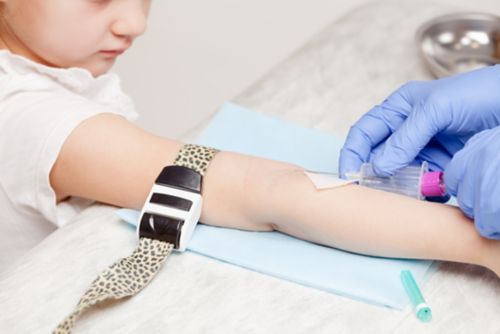What is venipuncture?
Venipuncture is the insertion of a needle into a vein. The needle is free from germs (sterile). Your child’s health care providers perform this procedure. They might also call this a “stick.”
The care team does venipuncture to:
A tube that stays in your child’s body so that they can get medicines or fluids is an IV. IV stands for intravenous (inside the vein). Your child might need an IV if they do not have another type of central venous line, such as a tunneled central line, subcutaneous port, or peripherally inserted central catheter (PICC).
If your child has another device, they may need an IV to get more medicine, fluids, blood products, or perform more tests.
Preparing for venipuncture
Getting a stick can cause mild to moderate pain. The staff can make your child more comfortable by:
- Letting you or a family member be with your child if it helps calm them or if your child asks for it
- Using comfort positions to help them keep still and safe
- Distracting them to get their attention on something else (such as blowing bubbles, watching a pinwheel, laughter, virtual reality goggles, or oral sucrose (tastes sweet) for children under 24 months of age.
- Putting a numbing cream (anesthetic) on the skin to numb it.
A care team member might hold your child to keep them safe during the stick.
To make the stick happen more quickly, the care team may do some things to see your child’s vein better and do the stick more quickly, such as:
- Place your child’s arm, hand, or another area where the needle goes lower than their heart.
- Use a tourniquet (a band that goes around your child’s arm)
- Wipe the area with alcohol
- Use heat, such as a warm compress.
- Ask your child to make a fist. A tourniquet band around the arm helps blood stay in the vein so that it is easier to see.
- Give extra fluids but only if your child is allowed to drink
- Use a small device called a vein finder
The best option depends on your child. Every child is different. Once your child is ready and the vein has been located, the staff will:
- Insert the needle into your child’s vein. An IV usually goes in the arm, hand, or foot. But it can go in another vein if needed.
- If your doctor orders a test that needs a blood sample, the staff will collect the blood in vials or tubes.
- The staff will remove the needle and apply a bandage.
Alternatively, they may place an IV in your child if needed.
Problems with venipuncture in children
Needle sticks can be upsetting for children and their parents. It is important that you know that:
- The staff member will try to put the needle in your child’s vein on the first try.
- Sometimes it takes more than 1 try to place a needle.
- You might see the nurse move the needle under the skin a little after insertion. Veins often move slightly. The needle must be in the right position.
- This procedure may be stressful for you and your child. Care team members want to place the IV in the easiest way possible with the least pain for your child.
- It may be hard to put the needle in the veins of some children (“hard- to-stick” veins).
- If your child has been stuck several times in 1 spot, the nurse might not be able to use that spot again.
- The care team might need to find a new spot that others have not used. These new spots might be hard to stick.
- Even if your child had no problems before, a vein might be hard to stick.
Please let the care team know if you think your child has hard-to-stick veins, has been stuck recently, or has had problems in the past.
If the staff cannot put in an IV, your child might get their medicines by mouth. The health care team might also give them in a single injection (shot). Your child’s doctor will decide what is best for your child.

